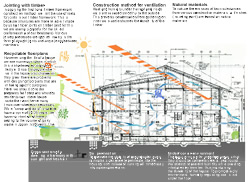Roof and the wind
Basic cross-sectional structure of passive design
 |
|||
| Cross-section of a dwelling in harmony with sunlight and fresh air | |||
 |
|||
- Effective use of sunlight: Adjusted by incorporating openings (windows) that screen the summer sun but trap light inside the house in winter, aided by the degree of protrusion of the eaves. Moreover, by installing a monitor roof, hot air is also discharged naturally. The basic principle is to create an air environment that follows natural principles.
- Soil infiltration: To promote the stability of groundwater levels, rainwater is made to infiltrate into the housing land, instead of running off immediately into wastewater drains.
- Construction method for ventilation: Heat and humidity under the roof and inside walls are released smoothly to the outside. This prevents condensation from gathering on inner walls and enhances the durability of the timber.
- Natural materials: To reduce the emission of toxic substances from various construction materials, all finishes (including paint) are based on natural materials.
-
Jointing with timber: In applying the traditional timber framework construction method, we limit the use of metal for joints. This is because structures are more reliable if made by using timber joints on timber. Various joinery processes are applied, mainly in the form of straight joints and angle joints between members.
- Recyclable floorplans: Creating floorplans that are limited to specific purposes is a factor that in itself shortens the life of a house. Since the people who live in the house also change as they grow, designing changeable floorplans whereby residents can “move house” inside their own home whenever necessary is the basic principle behind long life, as well as recyclable floorplans inside the house.
Previous Building |
 |
 |
 |
 |
 |
 Next Building Next Building |
CASBEE is a method for rating the environmental performance of buildings using Building Environmental Efficiency (BEE) as an indicator, which is based on the results of separate scores obtained for Q-1~Q-3 (Quality) and LR-1~LR-3 (Load Reduction).















 | Copyright © 2008 Institute for Building Environment and Energy Conservation, All Rights Reserved.
| Copyright © 2008 Institute for Building Environment and Energy Conservation, All Rights Reserved.